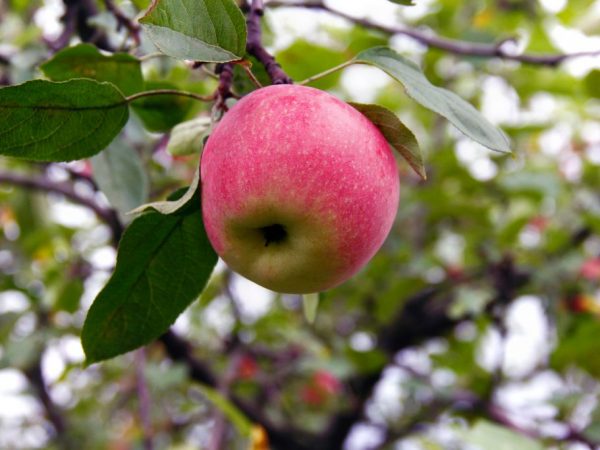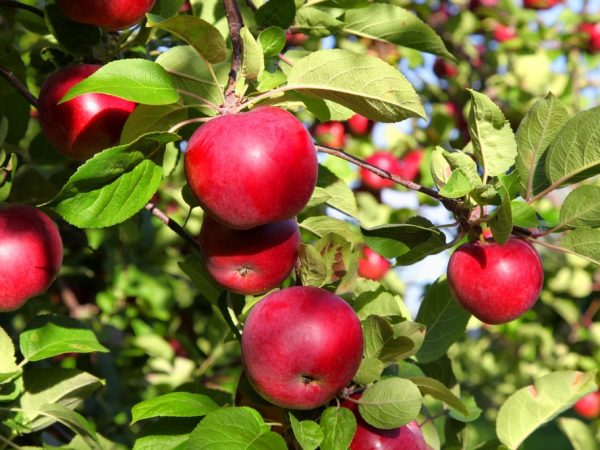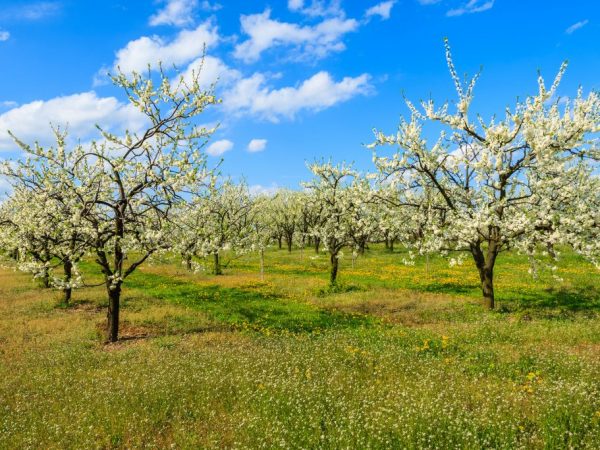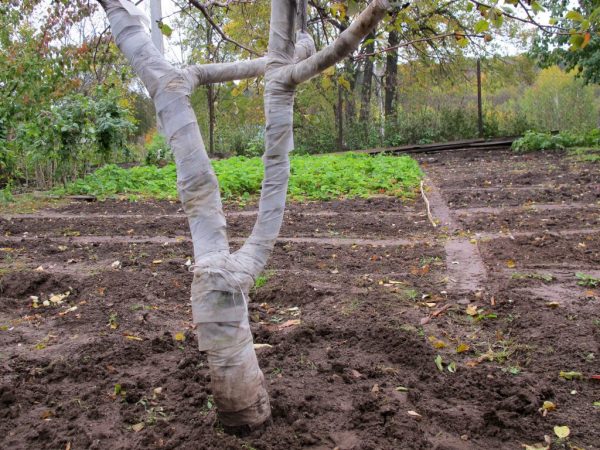Description of the apple tree Krasa Sverdlovsk
Fruit trees that can withstand severe winters are in great demand among gardeners. One of the best representatives is the Krasa Sverdlovsk apple tree. The variety was bred by the residents of Sverdlovsk, recognized as the best novelty in 1979, registered in the State Register of Breeding Achievements in 1992.
- Description of the variety
- Pollinators
- Transportability
- Winter hardiness
- Disease and pest resistance
- Application
- In which regions are they grown
- Tree lifespan
- Advantages and disadvantages
- Landing technology
- Optimal timing
- Seat selection
- Landing technology
- Planting scheme on different rootstocks
- Care
- Watering
- Top dressing
- Pruning and shaping the crown
- Prevention of diseases and pests
- Preparing for winter
- Features of ripening and fruiting
- Harvesting and storage
- Forms and options for growing
- What gardeners say

Description of the apple tree Krasa Sverdlovsk
Description of the variety
Krasa Sverdrovsk is a medium-sized apple tree, the crown is filled, resembles a ball in shape. The branches are crooked, the bark is brown.
The fruits are large, even, uniform in size, the average weight is up to 160 g, some specimens can reach 240 g. A blurred blush is observed almost over the entire surface.
The taste is sweet with a slight sourness, the pulp has a delicate aroma with a pleasant spicy aftertaste.
Chemical composition per 100 g:
- 13 - 15% sugar;
- 16 - 19% dry matter;
- 20 - 31 mg vitamin C (ascorbic acid);
- 302 mg vitamin P (P-active substances);
- 300 - 406 mg of catechins (natural antioxidants).
The yield of this variety is estimated by experts to be above average. Trees begin to bear fruit regularly at 6-7 years, the yield from one tree can reach 75 - 100 kg.
Pollinators
Since the apple variety Krasa Sverdlovsk is self-fertile, for its pollination it is necessary to have pollinators on the site - trees of other varieties, the period of flowering and vital activity of which will coincide.
Transportability
Before harvesting, the fruits are firmly held on the branches, therefore they have good transportability. For better preservation, apples are harvested unripe, while they are yellow-green in color.
When lying down, the fruits ripen, and with proper storage in a cool dry place, they do not lose their taste and retain their presentation until April - May.
Winter hardiness
In the Volga-Vyatka region, this variety retains an average winter hardiness along with standard varieties. It is better to grow on windless hills, in regions where the climate is harsher - in stanza form.
Disease and pest resistance
The variety is relatively resistant to common diseases such as scab, apple crayfish, fruit rot and powdery mildew.
Application
Apples are used as a dessert, they are also suitable for different types of processing: compotes, jams, confitures, drying and juices.
In which regions are they grown
Initially, the variety was recommended for use in the Volga-Vyatka district, gradually became widespread not only in the southern regions, but also in the Urals, Altai and Western Siberia.
Tree lifespan
With a favorable climate and good care, the apple tree can bear fruit for 25-30 years, the stale variety - up to 20 years.
Advantages and disadvantages

The fruits are versatile in use
The indisputable advantages include the excellent quality of apples: during long-term storage, keeping quality is above average, one-dimensionality of fruits, non-shattering until harvesting, dessert taste and universal use.
The disadvantages noted in the characteristics include a relatively average winter hardiness. On young trees, a significant part of the fruit is formed at the ends of long fruit twigs, which complicates care: it is necessary to shorten the fruit twigs by spring pruning or summer pinching.
Landing technology
Optimal timing
It is better to purchase seedlings just before planting and plant in early spring, having prepared a hole in the fall. When planning an autumn planting, it is better to do this shortly before the onset of frost, optimally - a month before planting.
Seat selection
It is better to choose a bright place, not blown by wind and drafts. Requirements for the soil: moisture capacity, fertility, neutral acidity, loam is quite suitable. Do not forget that the presence of pollinating varieties is mandatory in the neighborhood.
Landing technology
When purchasing seedlings, you should pay attention to their appearance: the bark and roots must be strong and healthy, without growths, rot and other damage. The leaves on the seedling must be torn off immediately if planting is carried out in the fall.
Beforehand, the roots are briefly immersed in water at room temperature and the condition of the seedling is examined: we cut off the damaged and dry roots to a healthy place.
The hole should have a diameter of at least 50 cm, and the depth will depend on the length of the roots of the seedling, usually 50-60 cm.
During digging, the upper part of the earth, rich in humus, is separated, and the lower, less fertile, is removed to the side. Add to the top layer:
- superphosphate - about 250-300 g;
- potassium chloride - 50 g;
- wood ash - 0.5 kg;
- humus - 15 kg or more.
The seedling is placed on a mound of soil mixture, the roots must be carefully straightened, then sprinkled with earth. As the earth is poured, the seedling is shaken, and the earth is poured in layers. The root collar should remain 5-6 cm above the ground. A peg is placed next to it, to which a tree should be carefully tied and well watered with 2-3 buckets of water.
Around the trunk, the ground is trampled down and surrounded by a roller, on the device of which the lower layer of soil can be used.
In order to prevent a decrease or increase in temperature, the trunk circle should be covered with any material suitable for mulching: dry leaves, sawdust, straw.
Planting scheme on different rootstocks
The distance between trees on a vigorous rootstock should be 5-6 m, on dwarf and semi-dwarf ones - it is enough to keep the distance between plants 2-3 m, and between rows - up to 4 m.
Care
Watering

The number of waterings depends on the weather
If the trunk circle is not mulched, it is necessary to regularly monitor the soil moisture. The watering rate depends on the size and age of the tree:
- one year - at least 2 buckets twice a week (increase the quantity in extreme heat);
- two years - water less often, since the roots are able to get moisture from the soil themselves, when hot weather is established - water with 2-3 buckets;
- from three years - watering is necessary only in dry, hot weather and during the ripening of fruits.
Top dressing
According to the description of agricultural technology, timely and competent fertilization of the soil helps to increase the yield and strengthen the immunity of the apple tree. Top dressing with mineral and organic fertilizers is carried out regularly.
The first one - when the first leaves appear: in order to increase the green mass, root feeding is required, containing a lot of nitrogen: urea - 500-600 g or nitroammophoska - 30-40 g.
The second is carried out at the very beginning of flowering: 100 g of superphosphate, or half a bucket of slurry, or 300 ml of urea is taken for one bucket of water (10 liters). One apple tree requires up to 4 buckets of fertilizer.
The third - during the amicable ripening of fruits. The most popular among gardeners are two options:
- 500 g of nitrophoska and 10 g of sodium humate are diluted in 100 l of water. For each tree, the rate is about 30 liters.
- Green fertilizer - greens are placed in a large container by 2/3 of the volume, poured with water, tightly covered with a film and left to ferment for two to three weeks. Several holes are made in the film for air access. The finished fertilizer is diluted with water in a ratio of 1:10 (for 1 part of the fertilizer, 10 parts of water).
The fourth - after harvesting, since the apple tree needs phosphorus-potassium fertilizers before winter: 1 bucket is consumed per m², in which 1 tbsp. l. potassium and 2 tbsp. l. double superphosphate.
Pruning and shaping the crown
In addition to the climate, soil fertility and timely fertilization, the quantity and quality of the crop is influenced by regular pruning of branches and the correct, systematic formation of the apple tree crown.
The first spring pruning is carried out before the swelling of the buds on a 2-year-old tree: the growing point is split. This promotes the formation of side shoots.
Then, annually in the spring of last year's shoots are shortened by one third to form fruit branches. A properly cut tree crown should be spherical.
To obtain larger fruits, it is necessary to thin out the ovaries: cut out the central fruit from the middle of the inflorescences, and also remove curves, damaged or very small apples.
Prevention of diseases and pests
Despite the high resistance to various pests and diseases, timely preventive measures are needed to keep the garden healthy.
The safest way is to plant plants near fruit trees that emit phytoncides, which are good at repelling sucking insect pests.
Broad-spectrum insecticides, applied with all precautions, will help kill all kinds of parasites.
In order for the apple tree to be affected by fungal and infectious diseases as rarely as possible, it is necessary to maintain its immunity: water it on time, remove dried and unhealthy branches and leaves, and weed the area in a timely manner.
If you notice that small leaves appear on the tree, you can help by planting legumes nearby - they consume little zinc, while phosphorus is converted into readily available phosphates, which has a beneficial effect on the condition of apple trees.
Preparing for winter

Before the onset of cold weather, it is necessary to insulate the trunk
It is especially important to properly prepare the apple tree for the first winter period. The trunk is wrapped in burlap, insulation or thick cardboard, trying to make sure that the bottom does not touch the soil, and the upper edge reaches the first branches.
The root layer is carefully mulched with grass, sawdust or dry foliage. You can use artificial insulation, with one condition that it will not absorb water.
We warm the tree from the first snowfalls, shoveling snow onto a circle of earth adjacent to the trunk. The root collar can be insulated with agrofibre, and the rest of the ground part of the trunk with thick light paper.
To protect a young tree from damage in severe frosts, the snow layer should be about one meter.
In places with a harsher climate, the stlate-type crown is pinned to the soil so that in winter the whole apple tree is covered with snow.
Features of ripening and fruiting
The variety has a rather long period from planting to the appearance of the first apples - 6-7 years. In the Volga-Vyatka region, flowering begins in May, in the southern regions - a little earlier, in areas with a colder climate - later.
The greatest number of fruits is formed on annual branches.To increase the yield, annual shoots are shortened and the lateral shoots are carefully cut. These measures form the correct crown and ensure the branching of new shoots and the setting of the largest number of fruit buds. Improves fruiting by thinning inflorescences for larger fruits.
Harvesting and storage
According to the State Register of Breeding Achievements, Krasa of Sverdlovsk is a late-ripening variety. In early autumn, the apples are still tough, greenish. Their distinctive properties - original taste and bright color - they acquire only in winter.
Thanks to this, the variety is normally transported and stored without loss until the end of spring.
Forms and cultivation options
- The dwarf form of cultivation is preferred by many gardeners due to a number of advantages: the plants become smaller, more trees can be placed on one area. In addition, fruiting occurs two or three years earlier, and the yield increases.
- It is easier to care for undersized, compact apple trees - cut, spray, collect fruits. In low-growing trees, the roots are shallow and respond more quickly to watering and fertilization.
- The stem shape of the tree is often used for this apple variety. With this method, it is necessary to insulate well the trunk of the tree and the base of the branches that form the crown of the apple tree in winter.
- Creeping (or stale) form. In the Northern Urals, Siberia and Altai, the variety is grown mainly in stanza form. In winter, the crowns of apple trees, pinned to the ground, are additionally covered with spruce branches, and carefully covered with snow from above.
What gardeners say
The beauty of Sverdlovsk is undoubtedly among the best winter varieties of apple trees cultivated in regions of different climatic zones. Samodody only respond positively to her. They note both the taste of the fruit, and the size of the harvest, and aesthetic satisfaction with the appearance of the tree.
Adhering to the outlined tips and recommendations, you can get an excellent harvest, which until the end of spring will remind you of a warm sunny summer and delight with a bright ruddy color and juicy taste.

